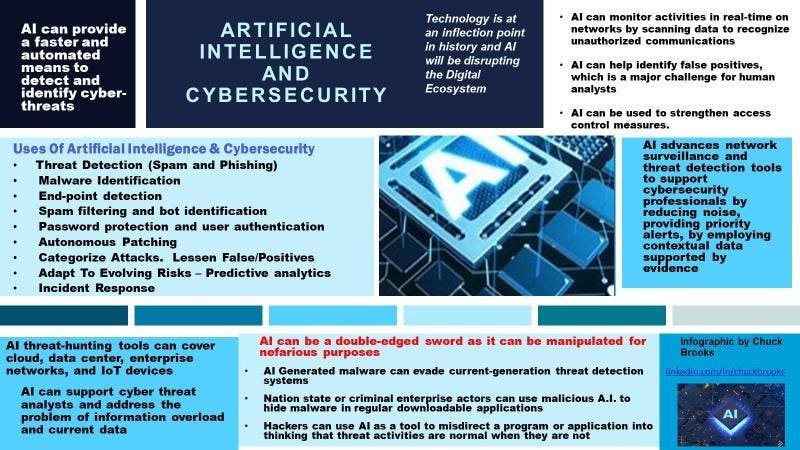The topic of artificial intelligence’s rising involvement in our digital world and its associated opportunities and challenges have been the main topics of discussion at many security conferences and events in recent times. There is little doubt that humankind is on the verge of an era of exponential technological advancement, and AI is leading the way in the emerging digital world.
For cybersecurity, this tech trend has implications. In simple terms, artificial intelligence acts as a powerful catalyst and enabler for cybersecurity in our connected ecosystem.
What is connected, needs to be secure and resilient. That encompasses almost every industry or vertical in the global economy. How does artificial intelligence and cybersecurity mesh to accomplish that endeavor?
Computing systems that use artificial intelligence (AI) and machine learning (ML) are increasingly essential to cyber operations and have become a major emphasis area of cybersecurity research development. Security operators must be aware of everything on your system and be able to identify anomalies quickly, such as malware or misconfigurations, to stop breaches in today’s hyperconnected digital world. In a holistic sense, AI technologies can aid in defending against ransomware, social engineering, and malware that is becoming increasingly sophisticated and destructive.
Better cybersecurity can be enabled by AI in a variety of ways. An overview and an infographic that might serve as a starting point for understanding some of the uses of AI in cybersecurity are provided below:
Ways AI Can Assist Cybersecurity:
Artificial intelligence (AI) systems aim to transcend human speed and constraints by mimicking human characteristics and computing abilities in a computer. By prioritizing and acting on data, AI algorithms can facilitate more effective decision-making, particularly in bigger networks with numerous users and factors. Finding, classifying, and combining data are incredibly useful skills for reducing cybersecurity risks.
Cybersecurity can benefit from the application of AI and ML in the domains of threat intelligence and network surveillance. Intelligent algorithms can be used to keep an eye on network anomalies, spot emerging dangers without established signatures, and detect them. Additionally, it can be used to correlate data from silos to evaluate network risks and vulnerabilities as well as comprehend the nature of attacks. By cross-checking the accuracy of data across numerous dispersed databases, artificial intelligence and machine learning may be able to assist identity management.
By analyzing data and files to identify illegal connections, unwanted communication attempts, odd or malicious credential use, brute force login attempts, anomalous data transfer, and data exfiltration, AI can monitor network activity in real-time. This makes it possible for companies who provide cyber-defense to make statistical deductions and guard against anomalies before they are discovered and fixed.
AI and machine learning can help enable automated and adaptable network applications. Horizon scanning and network monitoring that can provide real-time reports on deviations and anomalies are made possible by automation. IoT devices, cloud, data centers, and workplace networks can all be covered by AI threat-hunting solutions. It makes cybersecurity diagnostic and forensics analysis as well as the defense framework’s layers of network, payload, endpoint, firewall, and anti-virus software automatically updated.
By combining orchestration procedures, automation, incident management and collaboration, visualization, and reporting under a single interface, AI and ML can also help Security Orchestration Automation and Response (SOAR) products. Additionally, SOAR can give security operations center (SoC) employees a quicker, more precise approach to manage the massive amounts of data generated by cybersecurity systems and assist in locating and resolving potential or active attacks.
In the forensics of a breach, the question “what happened” can be answered by descriptive analytics offered by network surveillance and threat detection technologies; the question “why and how did it happen” can be addressed by AI-enabled incident diagnosis analytics. To uncover the answers to those queries, artificial intelligence (AI)-powered software programs and platforms can analyze historical data sets to look back at change and anomaly indicators in the network activity.
Predictive analytics may offer information on the ramifications of system vulnerability exposure if incident investigation reveals one (as opposed to malicious exploitation). Prescriptive analytics can be used to respond to an occurrence based on recommendations to contain and permanently eliminate its causes after those causes have been determined. These suggestions can be put to many different uses, such as adopting new policies or procedures, changing tactics, or adopting targeted measures.
See Chuck Brooks and Dr. Frederic Lemieux’s article, “Three Key Artificial Intelligence Applications for Cybersecurity,” for a deeper look at some of the capabilities AI can bring to cybersecurity
While artificial intelligence (AI) and machine learning (ML) might be useful tools for cyber defense, they can also be double-edged swords that criminal hackers can utilize for bad intentions:
Criminal hackers have embraced AI at a rate that is faster than most commercial cybersecurity teams, and they may utilize it for their own purposes. The statement “There are already instances of threat actors and hackers using AI technologies to bolster their attacks and malware” is found in the Forrester Research paper “Using AI for Evil: A Guide to How Cybercriminals Will Weaponize and Exploit AI to Attack Your Business.”
Goh Ser Yoong, an expert in IT and cybersecurity, claims that generative AI can swiftly produce new material based on inputs such as text, images, and sound by utilizing deep neural networks machine learning algorithms. The output from generative AI models, which includes text, audio, and video as well as photos, is very lifelike, he says. An attacker successfully employed AI-generated speech files to mimic a CEO to obtain bank account information unlawfully since the output is so lifelike. See: Intersection of generative AI, cybersecurity and digital trust | TechTarget
Artificial intelligence (AI) can be used by nation-states and/or criminal organization actors to conceal malware in commonly downloaded programs. After being downloaded, the malware is activated after a predetermined amount of time by one or more elements. Attacks that take a long time to execute present a chance to gather user data (identity management features, authentication process). Intelligent malware that learns from both successful and unsuccessful attempts can potentially be aided by malicious AI (Deep Exploit). Subsequently, intelligent malware can replicate itself by identifying and taking advantage of weaknesses in systems and adjusting to countermeasures by launching novel attacks. Malicious AI is also capable of launching covert attacks, adapting to an organization’s security environment through system maintenance.
It is likely that one of the most difficult cybersecurity tasks will be keeping up with sophisticated adversaries who wish to utilize AI (and quantum technology) for harmful or illegal activities. There is already an urgency to address such potential vulnerabilities by these actors, especially to critical infrastructure. R&D in AI between the public and private sectors, as well as allied nations, needs to be accelerated and are essential to advancing advanced capabilities and filling in cyber gaps—particularly with regard to asymmetrical technological threats.
For the near future, AI will have a disruptive effect on operational cybersecurity models. Risk management approaches and technology implementation will have to be continually adapted at the speed of smart algorithms. In the coming years, addressing novel and increasingly complex threats will be essential to maintaining business continuity and cyber-resilience. A thorough understanding of AI’s potential uses, benefits, and drawbacks is necessary for the future of cybersecurity.
Read the full article here








